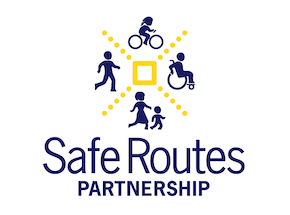The following publications are produced by the Safe Routes Partnership for use in advancing Safe Routes to School, active transportation, and shared use in all communities. To search for a publication on a specific topic, use the advanced search tool and start typing in "Safe Routes Partnership" in the author field, then select it from the list that appears.
Since 2017, the Safe Routes Partnership has worked with community-based organizations to make park access safe, convenient, and equitable for people walking and biking. However, making changes to a sidewalk or holding one community engagement meeting is not going to have as long-term of an effect if we don't zoom out to see the whole system that created unsafe routes or inequities in the first place.
State agencies have a significant role in influencing the funding and policy that affects local park access. The Safe Routes Partnership set out to work with states to establish collaboration between agencies whose work impacts local park access and build on opportunities for active transportation to all community destinations. The Safe Routes Partnership recruited six states over two years from a pool of 13 applicants to work on the internal systems that could support local park access.
The Safe Routes to Parks is a research-backed intervention to boost rates of physical activity that can have positive health benefits. In a systematic review, the Community Preventive Services Task Force found a significant increase in physical activity related to parks, greenways, and trails when they are paired with at least one other intervention – community engagement, structured programs, public awareness, and/or access enhancements.
Since 2017, the Safe Routes Partnership has partnered with community-based organizations, government agencies, and other national partners to improve local park access via walking and biking. In those seven years, we have shown that there is significant demand to unlock the full potential of neighborhood parks for health and community building by activating the routes to them. Along the way, this movement has highlighted the power of engaging parks and recreation stakeholders in creating safer, more equitable streets, ensuring that parks are integral to connected, thriving communities.
Parks play a role in supporting public health, from mitigating the impacts of climate change to reducing depression and anxiety. A 2022 systematic review by the Community Preventative Services Task Force – part of the U.S. Department of Health and Human Services and supported by the Centers for Disease Control – emphasized the importance of Safe Routes to Parks for maximizing the health benefits of parks, greenways, and trails.
We’ve developed state report cards which provide a snapshot of how supportive each state is of walking, bicycling, and physical activity for children and adults as of 2024.
A Community Power Map is a visual tool to help you identify individuals, organizations, or institutions that may influence the outcome of the positive changes to increase park access in your community. This resource was created to guide you in developing your own community power map to build connections and improve park access.
Multimodal trails are off-road routes that can be used for walking and biking. This factsheet outlines ways that states advance equity goals through their multimodal trail programs: typically by defining high-need communities and then prioritizing them in project selection and funding.
This tool was developed to support people who are interested in a simple, structured approach to identifying the environmental and mobility-related characteristics of a
place, recording this information, and using this data to inform next steps. This tool was designed to support people who are experts of the place where they live, work,
or play.
This guide offers strategies for repealing traffic laws related to walking and biking that are racially enforced for advocates and organizations considering starting policy campaigns.

